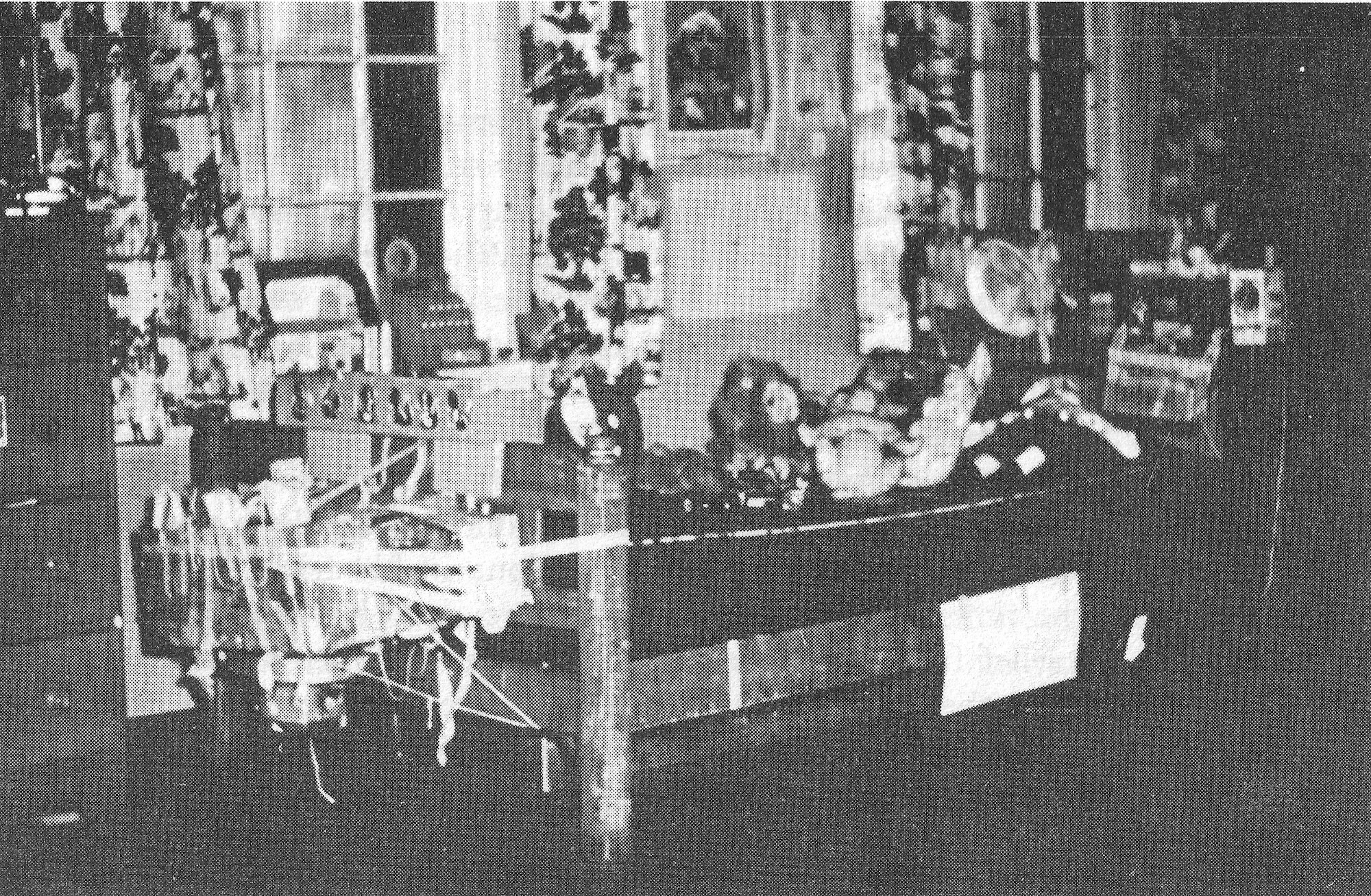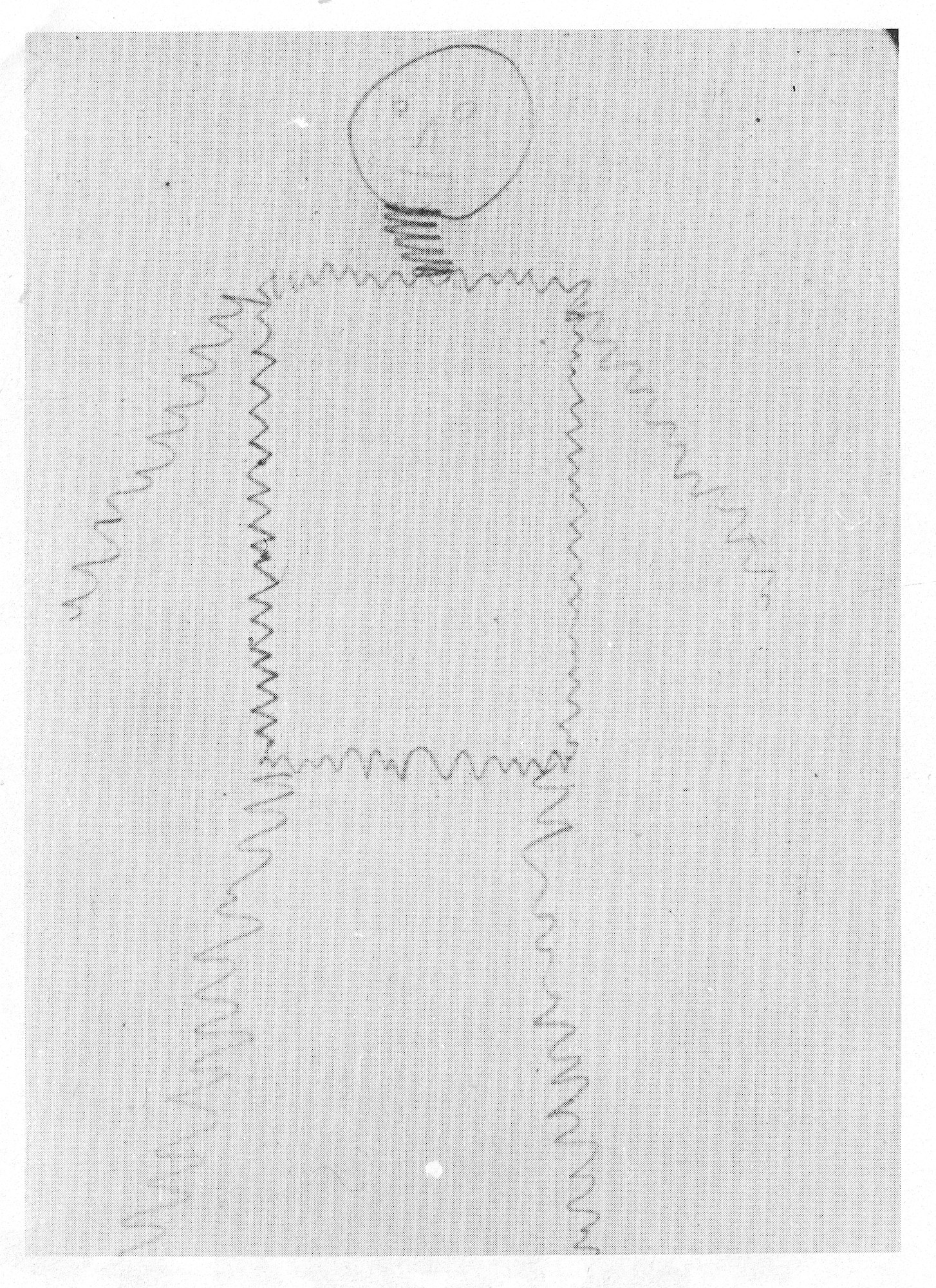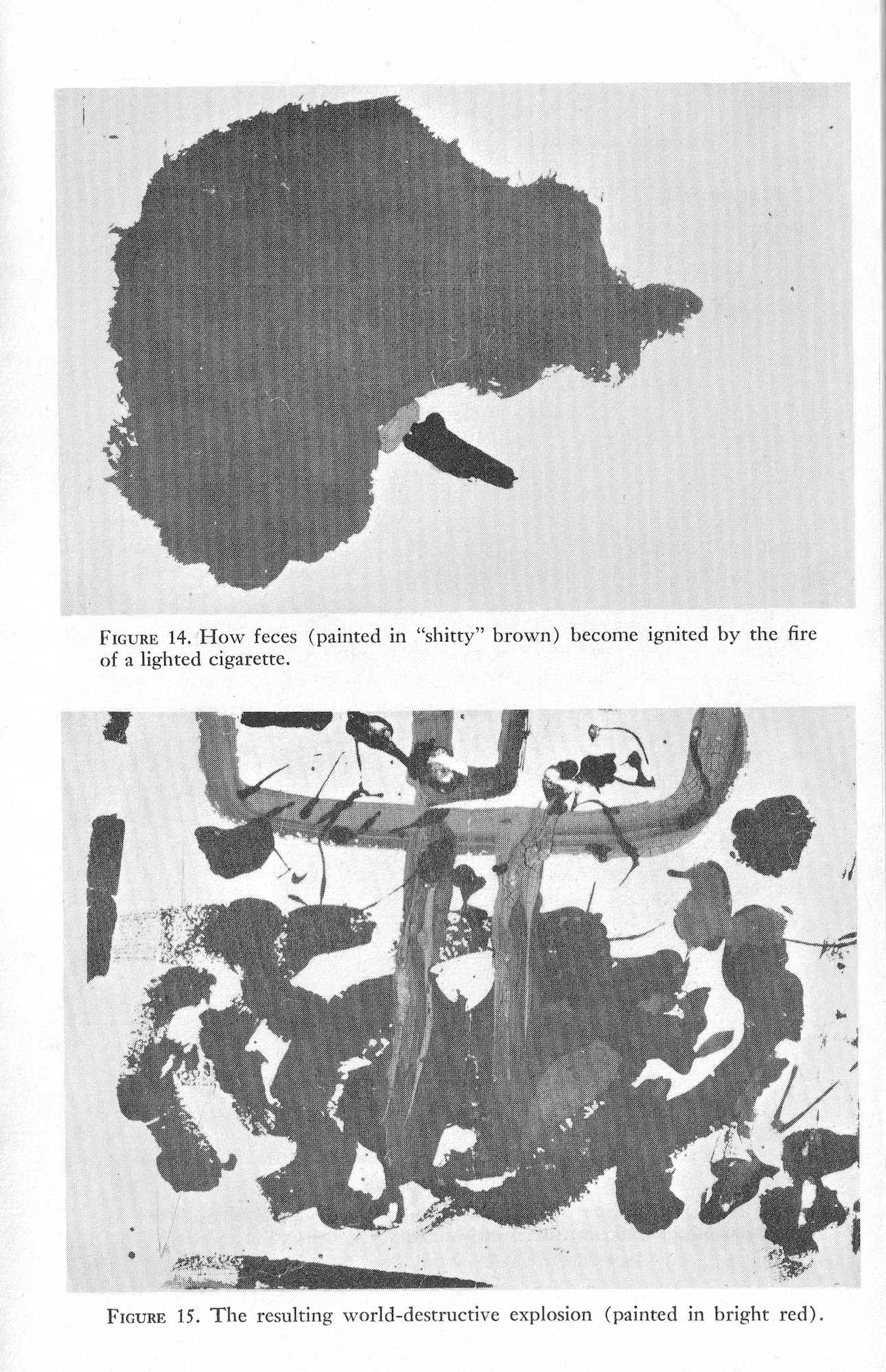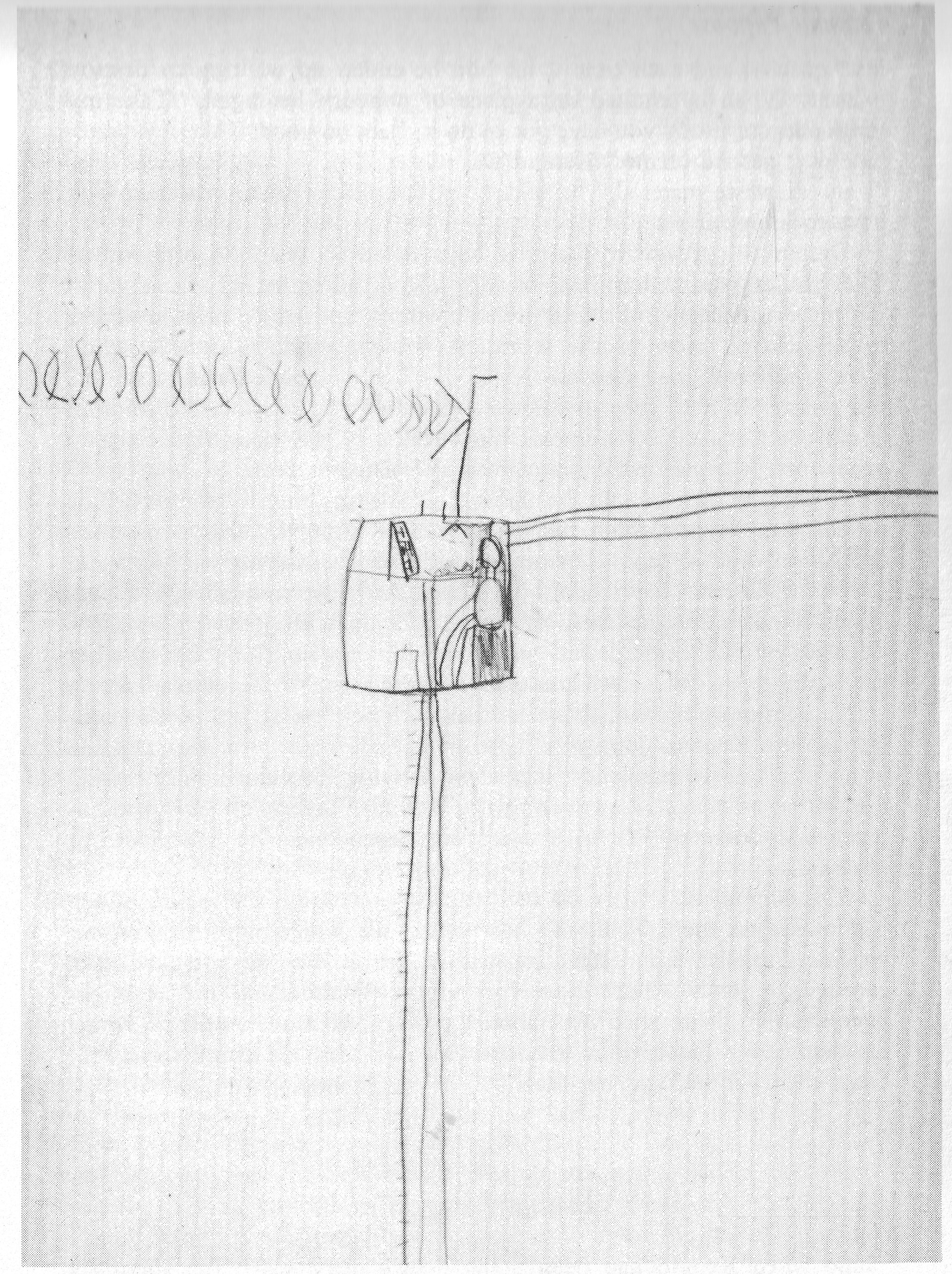On Evasion
Bruno Bettelheim, The Empty Fortress (New York: Free Press, 1967), 233-339 [courtesy of Scientific American]
Share:
The publication of drawings and sculptural objects by one so-called Joey in Scientific American in 1959 demonstrated the early historical attitude toward artworks by an individual explicitly described as “autistic.”1 The author of Joey’s case study, Bruno Bettelheim, was later discovered to be a charlatan. Bettelheim’s practice has been discredited, and his methodologies are now more frequently—and accurately—understood as abusive, but his work was nonetheless important to the creation of a discussion about autism in the United States after World War II.2 The details about Joey’s person as they are represented within Bettelheim’s work are problematic, and they may have been falsified, but they are crucial to the development of the notion of autism. Bettelheim’s book on his psychoanalytic research regarding autism, The Empty Fortress: Infantile Autism and the Birth of the Self (1967), is a discredited, factually unreliable text written by a fraud, but that text also archives the predicament of many autistic individuals. Joey’s life and work disrupted dominant understandings of human difference and demanded Bettelheim’s unreliable recuperative response.
The meaning of Joey’s expressions is inaccessible to his viewers, not because of Joey’s disability but because there is no archival representation of Joey other than Bettelheim’s unreliable and biased images and descriptions. Viewers have no unmediated access to Joey or his drawings. Joey might not have even been an individual person, but a hybrid of many different autistic patients that Bettelheim encountered. Therefore, I cannot presume to create an account of what was meant by Joey, or what his intentions were. I can, however, speculate about the impressions of autistic resistance and how they demonstrate the inadequacy of Bettelheim’s model as he desperately tries to fit them into his agenda. Even though Joey might be fictitious, I assert that he is still an agent because his representation evidences agential efforts to evade depiction.
Joey’s drawings possess an energetic potency that disrupts the immediacy of vision. Rather than interpreting Joey’s work as counterfeit with no accurate historical cachet, I will instead interpret it as incorporating fragments of the lived realities of the autistic children in Bettelheim’s care who were actively defying coherent representation by and in the terms of their analysts. I look to Joey’s drawings to demonstrate how, decades before the neurodiversity movement began, autistic people combated dominant institutional understandings of the neurological body with a politics of invisibility. Redrawing the boundaries of “the political” to include that which is invisible allows the inclusion of historically ignored subjects who might not be able to (or even desire to) access the visibility of the so-called public sphere.
Bruno Bettelheim, The Empty Fortress (New York: Free Press, 1967), 233-339 [courtesy of Scientific American]
The Machines
Joey lived in a world of his own making. Joey’s machines affected how people working and living in Bettelheim’s Orthogenic School in Chicago went about their daily lives. They interfered with Bettelheim’s ability to discipline his patients, his ability to represent his patients within his research, and even his ability to experience time and space in manners comfortable to him (which I will address later). Joey’s machines—such as his car machine—were elaborate engineering projects. Joey fabricated his machines from household items he found around the hospital: toilet paper rolls, rolls of tape, electrical wires, electrical plugs, telephones, clocks, radio tubes, flatware, and children’s toys. Joey repurposed these found objects into energy sources that propelled his body and directed his everyday activities. For example, Bettelheim wrote that Joey would wander from room to room, stringing an imaginary wire from his “energy source” (an imaginary electrical outlet) to the communal table. During mealtimes, he “insulated” himself with paper napkins before carefully grabbing his power source and plugging himself in. Only then could Joey eat.3 Appropriating material he found around him, Joey transformed the space of Bettelheim’s school into an energetic reservoir for his reality. Joey even ran on electricity: “Electricity that seems to flow through the wire, he made run through his body. It connected him to a power source larger than his own….”4 Plugging into machinery enabled Joey to open his body and commune with organic and inorganic substances on the same plane as humans. His desires repurposed the disciplinary space of the clinic into a mechanical complex. The wires that Joey installed throughout Bettelheim’s school were interpreted as the material detritus of an “insane” child. Bettelheim considered the usefulness of these machines to be delusional—they had utility only if one had confidence in the reality of Joey’s experience. In other words, according to Bettelheim, Joey’s disability was that he considered his delusional world to be real. His creations are better viewed as ritual objects that intensified Joey’s embodied experience of an invented world, perhaps to make his life more bearable under Bettelheim’s care.
Bruno Bettelheim, The Empty Fortress (New York: Free Press, 1967), 233-339 [courtesy of Scientific American]
Joey’s relationship with the inorganic world of electricity is evident in the image Bettelheim presented as a self-portrait: the interior of Joey’s torso is composed with the same negative space that surrounds him—the only content of his body are its contours, which suggest electrical wire charged with zigzags. The drawing does not represent the wire using straight lines—which would convey the material shape of the copper strip—but the waves of energy that ran along them. Therefore, the image suggests that Joey did not experience his body as a material enclosure but as an energetic threshold, ready at any moment to mutate its shape or merge with another object. Perhaps the portrait depicts Joey’s body the moment before he plugged himself into one of his apparatus. He appears to be in a state of repose, calmly accepting energy through his wires, when his body and personal rituals are not being disrupted by interference. His arms and legs have no joints, yet they tremble with intensity. His “movements” are vibrational—electrical—rather than skeletomuscular. He did not act upon electrical tools as their master, but with them. In fact, he was composed of the same energetic materials that made them functional. Rather than an autonomous agent, Joey is depicted as a conductor of energy, as an entity formed by the same electrical forces that animate the objects of everyday life.
The Explosion
According to Bettelheim’s description, Joey refused to interact with the world as a normative subject—as a person. If anyone disturbed Joey’s rituals, he would communicate how troubled such disturbances made him feel by having a meltdown. Bettelheim interprets such meltdowns as merely contingent and delusional panic episodes, as the externalization of previous trauma. Nevertheless, his descriptions of these meltdowns presuppose an agentic, autonomous personality—though here, autonomy is not configured in a manner familiar to Bettelheim. These episodes were often so distressing to Joey that Bettelheim likened them to explosions. Bettelheim noted that Joey would even destroy hospital property (to calm himself and possibly to retaliate) when he felt too overwhelmed:
There were the moments, for example, when a long span of non-existence would be interrupted by the machine starting up, getting into even higher gear, until its climax was reached in a shattering “explosion.” This happened many times a day, ending with Joey’s suddenly hurling a radio tube or light bulb that would splinter and burst with a crash. He had a remarkable ability to get hold of tubes or unscrew light bulbs before we knew what was happening. If one of these was not around then a bottle would do, or any object that was easily shattered.5
Bettelheim (who condescendingly describes Joey’s calm as a “span of non-existence”) perceives Joey to experience extremes in energy levels, like the binary states of an off/on switch. However, the movement between these states was not arbitrary. Joey might have been a machine, but he was not just a simple oscillator. Joey referred to many of his machines as “preventions”—they comforted him and soothed him—and if they were interfered with at all, Joey would have a tantrum, often destroying household items both for catharsis and to communicate his distress. Bettelheim pathologizes such responses to danger or stress, perhaps as a step to limit their ability to interfere with his practice. While “exploding,” Joey expressed the willful desires of his autistic subjectivity even if it entailed punishment—such as Bettelheim’s infamous beatings.
Bruno Bettelheim, The Empty Fortress (New York: Free Press, 1967), 233-339 [courtesy of Scientific American]
Two compositions depict Joey’s explosions. Like the contemporaneous paintings of the abstract expressionists, these images conveyed raw affect over subject matter. The first image consists of bright red splatter emanating from the core of the composition, like a fireball or a splash of blood.6 The represented explosion has no content other than the disturbance. Bettelheim paired this image with another, which he interpreted to depict feces about to be lit by a cigarette. The diptych conveys two different states: a state of unknown mass, and a state of unknown vitality: form and its combustion into energy.
Bettelheim included the two images in his published text, though his simplistic interpretations appeared only in captions. The image appears within a section titled “A Machine-Powered Body,” in which Bettelheim interprets (rather awkwardly and exploitatively) Joey’s defecatory behavior, but there is no indication at all within the composition itself that the brown mass in the diptych is feces.7 Bettelheim totalized Joey’s paintings within Freud’s psychosexual stages of development. The narrative framing of the images by Bettelheim’s captions asserted the capacity of psychoanalysis to interpret artistic gestures as evidence of pathologies, co-opting them within the universalizing theory of the psychic body. Bettelheim’s pairing of these two images conveys the combustion of totality: the rupturing of a structure (as depicted by the brown mass) into a possibility (as depicted by its combustion).
Joey’s work conjures a vitality that jams the representational schemas Bettelheim tried to advance with his analysis. In fact, Bettelheim confesses that he is unable to recreate Joey’s affects in his written representation of him. Bettelheim writes: “his delusions had such an impact which we, accustomed to living with autistic children, had experienced with no other child. I cannot recreate it in writing. The best I can do is to say that watching him interfered to a serious degree with our ability to experience and relate to him as human beings.”8 Writing—Bettelheim’s mode of disciplinary communication—cannot communicate what Joey was able to communicate, which should imply a communicative deficit on the part of Bettelheim and not his patient. But it would be inaccurate to say that Bettelheim could not represent Joey simply because he lacked the communicative imagination to understand his patient’s will. The formal effects of Joey’s drawings arrest the extraction of coherent knowledge on which Bettelheim sought to assert his authoritative claims.
The unrepresentable, that which cannot be conveyed but only implied, was frequently alluded to in his drawings. One of Joey’s “papoose” drawings depicts the artist in a small encasement, communicating with an unknown entity outside the compositional frame. Bettelheim interpreted this encasement as the fortress of the self, the inert shell into which Joey would hide to escape his emotional trauma, but the encasement could just as well convey Joey’s own sense of entrapment within Bettelheim’s care at the Orthogenic School. Joey’s drawing does not provide viewers all the details to understand exactly what he was doing.
In addition to thwarting representation, Joey turned his attention to outside energetic sources that escape representational thought, perhaps in order to make life more livable within his situation of enclosure. In his self-portrait, Joey is depicted as corresponding with energetic sources that are not represented, but which are implied by rhythmic waves emanating from outside the picture plane. He is suspended in a vague, unknown space, receiving or sending messages to an entity not depicted. By representing such an encounter within his therapy drawings, Joey’s drawing co-opts Bettelheim’s analytic methods to assert modes of communication that differ from dominant rubrics—valid forms of interaction not calibrated to normative ways of mediating information.
At the end of Joey’s case-study, Bettelheim forces a narrative about Joey’s “recovery.” According to Bettelheim, Joey responded well to treatment and gained the capacity for normal communication and social interaction. Rather than believing Bettelheim’s account, I think it is more fruitful to observe the locations within Joey’s drawings (as I have) that are indifferent to Bettelheim’s therapeutic notions, which cast Joey’s behaviors as problems to be treated rather than agentive gestures. In these locations we find an agenda that refutes Bettelheim’s: an agentive assertion of an alternative to normal human life, of an electric life unbound by the limits of bone and muscle.
Bruno Bettelheim, The Empty Fortress (New York: Free Press, 1967), 233-339 [courtesy of Scientific American]
On Visibility
Journalists and historians often describe Jim Sinclair as “the first person to articulate the autism rights position,” but his writing and activism from the late 1980s and early 1990s do not represent the introduction of the autistic subject to civil discourse.9 However significant, the activism of Jim Sinclair, Kathy Grant, Donna Williams, and others involved in the inception of Autism Network International represented an early successful effort of autistic individuals to make themselves visible as political subjects with civil rights that deserve protection.10 Their work was and continues to be important to the nascent Neurodiversity Movement, but they were not the first autists to resist dominant modes of representation from an autistic subject position.
In The Empty Fortress, Bettelheim describes how Joey’s behaviors affected the configuration of the space of the hospital (by claiming household appliances as parts of his body) and disrupted Bettelheim’s daily routine. Rather than submitting to the rules of conduct imposed by Bettelheim’s Orthogenic School, Joey affected the norms around him such that his analyst sometimes felt as if his patient were transporting him into another reality. Bettelheim amalgamated Joey’s representation in his case study to respond to a real disruption—something that threatened a dominant understanding, and that therefore necessitated silencing. I look to Joey to demonstrate how decades before the neurodiversity movement began, autistic people defied the medical co-opting of their neurological bodies through a politics of invisibility.
This feature originally appeared in ART PAPERS “Disability + Visibility,” Winter 2018/2019.
J.J. Kahn is an artist and writer currently living in New York City.
References
| ↑1 | Whether Joey was actually autistic has been disputed. In my analysis, I interpret autism as a historically contingent term that has been defined differently over time, so autistic individuals are those who have been institutionally defined as such. Whether Joey is truly autistic is of little interest to me in this essay. |
|---|---|
| ↑2 | Bettelheim’s Orthogenic School, which he directed between 1944 and 1973, is now notorious for its frequent emotional manipulation and corporal punishment. One 1990 article in the Chicago Tribune reported: “Of the 19 alumni of the Orthogenic School interviewed for this story, some are still bitterly angry at Bettelheim, 20 or 30 years after leaving the institution. Others say their stays did them good, and they express gratitude for having had the opportunity to be at the school. All agree that Bettelheim frequently struck his young and vulnerable patients. What is equally significant is that none of Bettelheim`s successors at the Orthogenic School now contradicts these reports.” (Grossman, “Solving The Puzzle That Was Bruno Bettelheim,” np). For more information on Bettelheim’s dishonest medical practices, consult The Creation of Dr. B: A Biography of Bruno Bettelheim (1997) by Richard Pollak.
See: Grossman, Ron. 1990. “Solving The Puzzle That Was Bruno Bettelheim.” Chicago Tribune. 1990. Pollak, Richard. 1998. The Creation of Doctor B: A Biography of Bruno Bettelheim. Simon and Schuster. |
| ↑3 | Bruno Bettelheim, “Joey: a ‘Mechanical Boy’” Scientific American, 200 no. 3. 1959, 117. |
| ↑4 | Bruno Bettelheim, The Empty Fortress (New York: Free Press, 1967), 236. |
| ↑5 | Ibid., 235. |
| ↑6 | Bettelheim states in his caption that the image is “painted in bright red” (ibid., 269). |
| ↑7 | Bettelheim writes that the image is “painted in ‘shitty’ brown” (ibid., 269). |
| ↑8 | Ibid., 238. |
| ↑9 | Andrew Solomon, “The Autism Rights Movement” (New York Magazine, May 25, 2008). |
| ↑10 | Emily Thornton Savarese and Ralph James Savarese, “‘The Superior Half of Speaking’: An Introduction” (Disability Studies Quarterly, 2009). |



